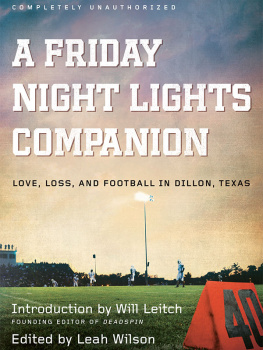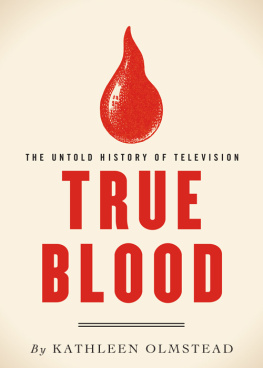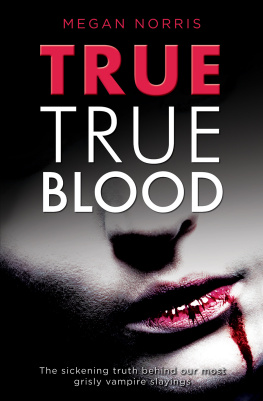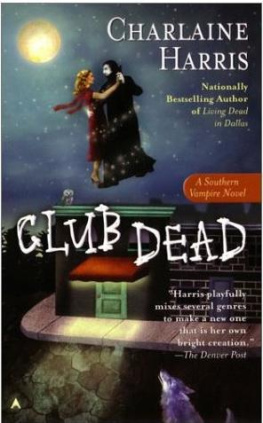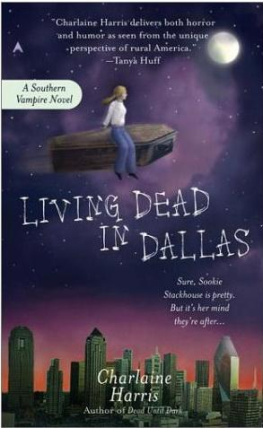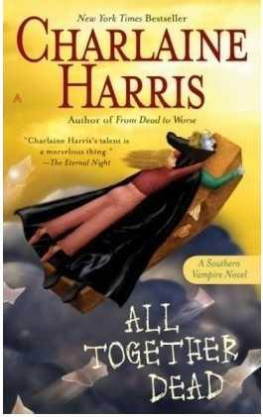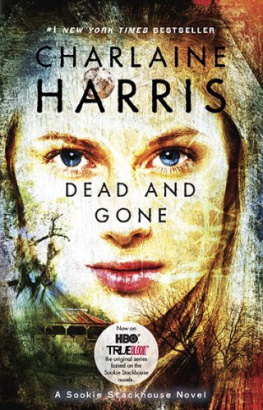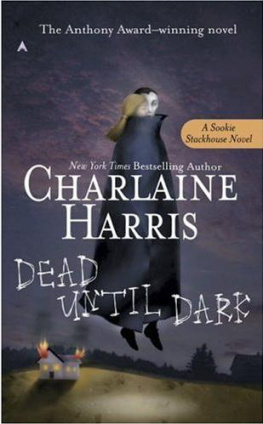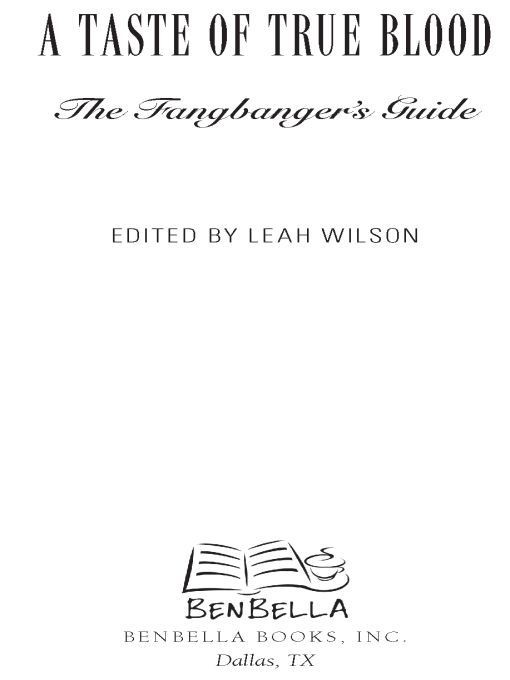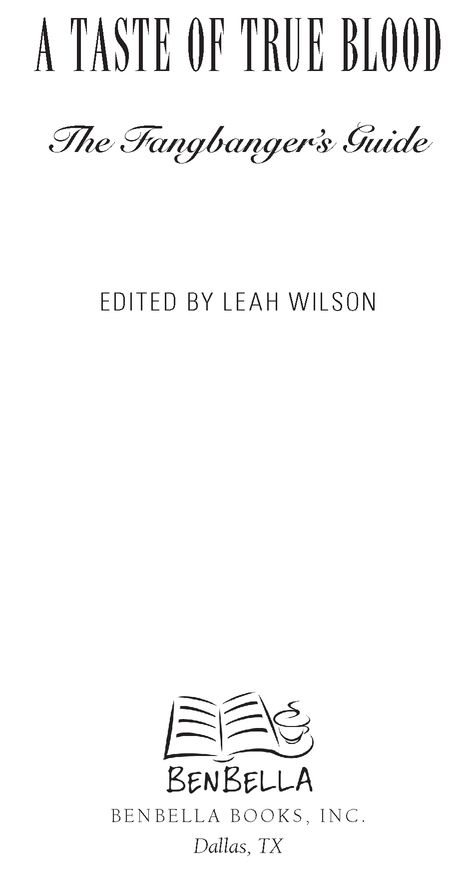Table of Contents
INTRODUCTION
I was reading the first drafts of the essays collected here at a coffee shop when I ran into a friend whod stopped in to grab an afternoon latte. She asked about the stack of papers and I explained that I was working on an essay anthology about True Blood.
Taking a surreptitious glance around, she lowered her voice, bent her head, and asked, But isnt True Blood pretty much, like, porn?
I could see where she was coming from. I could think of scenesSookie and Bills season one graveyard rendezvous; the more attractive moments of some of Maryanns season two orgies; pretty much any scene involving Jasonthat, if I were to come across them while flipping through cable channels, I might mistake for soft-core smut (with higher production values), too.
What you get out of True Blood, I think, depends on what you put in. (Granted, this is true of many things, both in life and on television.) If thats five minutes flipping through channels in a hotel room, its probably porn. But if thats an hour, religiously, once a week (plus DVD re-watches, time on message boards, conversations with like-minded friends), it can be a whole lot more.
If you want to watch for the sex, you can. If you want to watch to ogle Eric (Nordic, stoic, delicious Eric, with those bulging muscles, piercing blue eyes, penchant for T-strap tank tops, as Jonna Rubin sighs), or because you love Bill and Sookies romance, the show rewards that. You can watch for the complex social world... with an ever-expanding cast of interesting, engaging, and multidimensional characters, the way Karen Bethke does, or because its fun, the way her husband Bruce does. And if you watch for deeper themes (the twining dance of abandon and repression that Jacob Clifton sees in Tara and Jasons storylines), or watch to learn more about the human condition (the terrors of intimacy Carol Poole untangles in Sookies relationship with Bill and with Bon Temps), True Blood has that, too.
Its a pretty impressive feat, to work so well on so many levels. And its our goal to be a book that has something for all True Blood fans, no matter why they watch. We hope A Taste of True Blood will do just what its title says: give you a taste of what others see when they watch the showand give you a few new reasons to watch, too.
Leah Wilson
April 2010
VAMPIRE PORN
DANIEL M. KIMMEL
Great opening credits do more than introduce characters. They act as a gateway from the real world to the world of the show, and give us a framework with which to better understand the events were about to see. Daniel M. Kimmel dissects True Blood s credits, reminding us what an opening sequence can and should do for a showand stumbles onto a compelling and unexpected explanation for why its images unsettle us so much.
More than one person, told that I was writing an essay about the opening credits for True Blood, recoiled. It was something they had seen and now fast-forwarded through, unable to watch the montage of disturbing images. It was too weird or upsetting. (Mind you, these were people who then sat back and enjoyed a show where the heroine has sex with a vampire and that was fine.) Even at the 2009 World Science Fiction Convention held in Montreal, the panel on True Blood began with a discussion of the opening. The sequence is a startling compendium of images that both sets the stage for the show and constitutes a story in itself. It was put together by a production house called Digital Kitchen, which has also done the openings for Dexter and Six Feet Under, the latter show created by Alan Ball, the person behind True Blood.
Rather than go through a shot-by-shot transcript, its helpful to think of this sequence of seemingly random shots by its recurring motifs. (If you need to refresh your memory and dont have a DVD or an episode On Demand handy, the credit sequence is readily available as a standalone on YouTube and elsewhere on the Internet.) These motifs include the South, religion, bigotry, death, and sex.
Clearly these motifs are also the focus of the show. The location in rural Louisiana gives the show its particular small-town bayou flavor. Religion became a major subject in the second season, but right from the start the show was taken, in part, as a metaphor for the battle overand religious opposition togay rights. In the credits we see a sign that declares, God hates fangs, an obvious play on extremist religious protesters claim that God hates fags. Thus bigotry by humans toward vampires, even the good ones who drink Tru Blood instead of draining their mortal neighbors, is another obvious theme of the show. We also see bigotry from the opposite direction: by some vampires toward humanity. As for death, can you imagine a vampire story without it? From the undead vampires to the corpses of their victimsplus the bodies of those unfortunate enough to cross the paths of True Bloods other killers, human or supernaturalthe episodes are steeped in death. Finally, as for sex, it almost goes without saying that whos coupling with whom is one of the major forces driving the plot.
On a superficial level, therefore, the opening credits simply set the stage for the show. Yet if we removed the actual credits for cast and crew, the only thing that ties this sequence of images to the show is the appearance of the title True Blood in the latter part of the montage. None of the characters appear (as they do in the openings of such shows as Dexter and The Sopranos) and the scenes are not from past or future episodes (as with The Wire). So what is going on here and why does it creep us out to such an extent that some people cant watch the opening credits at all?
There seem to be three main reasons people find them disturbing. First off are those real images of unpleasant things that we usually dont think about. Whether its the startling bigotry of a little boy in the regalia of the Ku Klux Klan or the high-speed consumption of an animal carcass by maggots, the images are shocking precisely because theyre not fiction. Blatant hate and nature in the raw are disturbing.
A second level of creepiness is due to ambiguity, those images where were not at all certain whats going on. We think were reading the image properly and then something subverts it. At first glance the baptism toward the end of the credit sequence appears to be a statement of religious affirmation, but it also contains elements that make us question our initial impression. Why is it taking place at night? Why, after she is immersed, does the woman being baptized seem to be trying to escape and who are the two men pulling her back? We ought to be able to read this scene but we cant.
Finally there are images that are disturbing because theyve been given new context: either how the image has been edited into the sequence or the appearance of the film itself. An example of the former is the image of the man in the rocking chair grinning at us. By itself it might or might not be disturbing. Coming immediately after the boy in the KKK outfit it becomes a statement about how things are different here in ways we may not like. (A boy in a Klan outfit? You have a problem with that... Yankee?)The crumpling of the film in spots, and the drops of blood that appear not within the images but on top of them, are offered with no explanation at all, leaving us without a guidepost in a way that is particularly unsettling.


